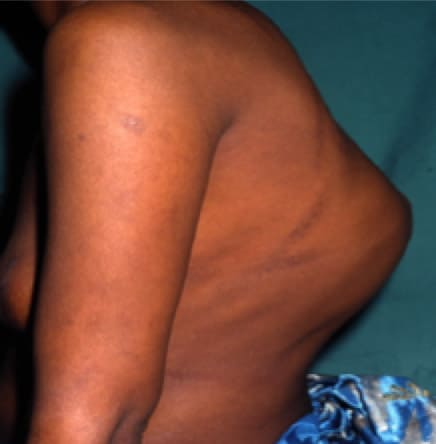 As many of you who regularly read this blog will know, I have a bit of a thing for TB. I hate it. It offends me. I am frustrated that a disease that was thought to be on its way to eradication a generation ago has fought back and we may soon find ourselves using pre-antibiotic era strategies to manage a disease that is thought to have been with humans since they first strolled out of the Rift Valley over 40 000 years ago (1,2).
As many of you who regularly read this blog will know, I have a bit of a thing for TB. I hate it. It offends me. I am frustrated that a disease that was thought to be on its way to eradication a generation ago has fought back and we may soon find ourselves using pre-antibiotic era strategies to manage a disease that is thought to have been with humans since they first strolled out of the Rift Valley over 40 000 years ago (1,2).
In the last 48 hours I have seen 5 patients with different manifestations of the disease and it brought it home to me that tuberculosis is a many-faced monster. I have decided to present some of the cases and the spectrum of tuberculous disease that they manifested.
Case 1: 46 year old male, presented with collapse followed by tonic clonic seizure. Spontaneous recovery to GCS 15. Otherwise well, some weight loss, denies cough initially, but later admits to a non-productive cough for some time.
Pulse 130 reg, BP OK, sats 95% RA, afebrile, fine crackles throughout lung fields. Neurologically intact.
Lactic acidosis on gas (resolved rapidly with 1000mls saline), HIV negative.
CXR:
Sputum induction revealed acid fast bacilli (AFB) on Ziehl-Neelsen staining.
Likely Diagnosis: First seizure secondary to miliary TB with tuberculoma.
Further investigation: In Australia we would CT his head. On contrast CT imaging early-stage lesions are low-density or isodense, often with oedema out of proportion to the mass effect and little encapsulation.
We treated him empirically with WHO standard TB combination therapy whilst we wait for the drug resistance result from the sputum.
Case 2: 15 year old male. Presented with 13 month history of fever, weight loss, lethargy and cough. Chose to present because of 2 episodes of haemoptysis. Had delayed his presentation due to school exams. Shares a dorm with 15 others!
C.V. stable with normal sats on room air. Febrile at 38oC. Chest examination normal.
HIV negative
CXR:
 Sputum: Positive for numerous AFB on ZN staining.
Sputum: Positive for numerous AFB on ZN staining.
Diagnosis: Primary pulmonary TB
Treatment: 6 month course of direct observed therapy short course (DOTS) with WHO combined TB therapy (for details see TB in the emergency department blog).
Case 3: 59 year old lady. Presented with fatigue, chronic cough, ankle swelling and fevers.
Cachectic, C.V. stable. Sats. 93% RA, afebrile. Decreased air entry on left side with crackle.
HIV negative.
CXR:
Sputum: Blood stained with scant AFB.
Diagnosis: Reactivation of latent pulmonary TB.
Treatment: WHO DOTS
Case 4: 7 year old boy. Asked to see patient by a colleague. Son of an employee, had been suffering intermittent fevers for over a year, approximately once a month. Seen by many clinicians and treated for malaria on each presentation. Abdo USS and CXR normal.
Very small for age, mother described normal development til 2-3 years prior. Pronounced bilateral cervical lymphadenopathy. Otherwise normal examination.
Fine needle aspiration: Initial microscopy reactive changes only. PCR positive for M TB.
Diagnosis: Lymphatic TB/ tuberculous lymphadenitis.
Treatment: DOTS
Case 5: 42 year old lady presents with severe back pain. Riding in the back of a public motor vehicle (PMV), a flatbed truck used to transport people about in PNG, PMV struck a pothole and patient was thrown in the air. Landed on her lower back/bottom. Sudden severe pain lower thoracic/upper lumbar spine.
Examination revealed a clinical gibbus. Very tender to touch. Had not been there previously according to patient and husband. Neurologically intact.
The patient looked a bit like this:
Diagnosis: Acute tuberculous gibbus secondary to axial trauma. Potts disease of the spine.
We are awaiting the analgesia to be effective and will monitor the patient overnight to check for neurological sequelae. We will transfer the patient, with spinal precautions, to the xray facility (by 4 wd over rough dirt tracks very slowly) tomorrow and investigate the deformity.
Treatment: Likely to be 2 fold with antimicrobial therapy and surgical stabilisation.
Xray may look like this:-
All these cases presented within a 36 hour period. There is clearly “a lot of it about”.
If the disease continues to develop resistance at the present rate we will all be facing a public health emergency in the coming years and will all become familiar with the many-faced monster that is TB.
- India reports cases of totally drug-resistant tuberculosis. The Lancet. Vol 379 January 21, 2012
- Wirth T, Hildebrand F, Allix-Be´guec C, Wo¨ lbeling F, Kubica T, et al. (2008) Origin, Spread and Demography of the Mycobacterium tuberculosis Complex. PLoS Pathog 4(9): e1000160. doi:10.1371/journal.ppat.1000160
Will Davies














